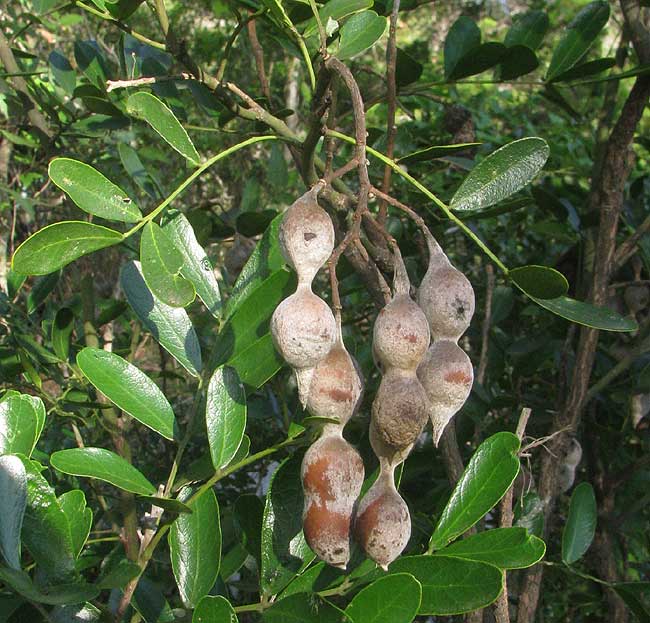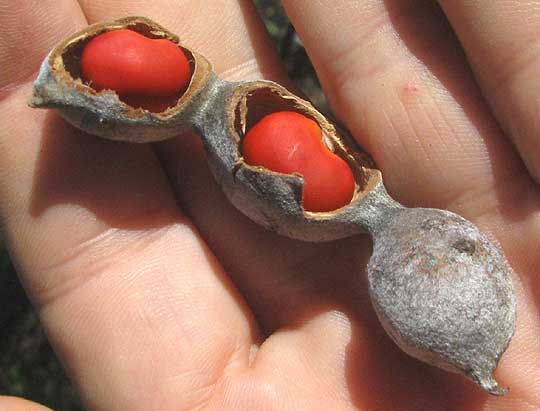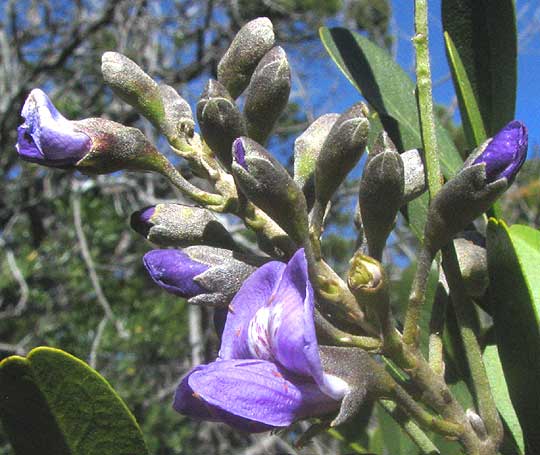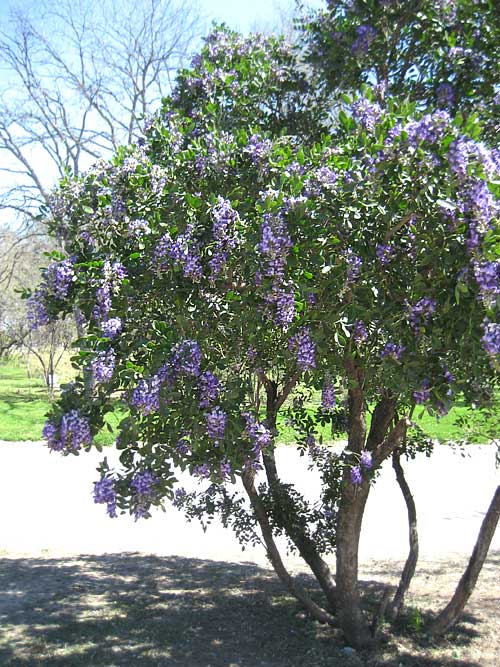Excerpts from Jim Conrad's
Naturalist Newsletter

from the the October 7, 2012 Newsletter issued from the valley of the Dry Frio River in northern Uvalde County, southwestern Texas, on the southern border of the Edwards Plateau; elevation ~1750m (~5750 ft); N29.62°, W99.86°; USA
MESCALBEAN
On rocky limestone outcrops along the little Dry Frio River behind the cabin and atop the nearby hill, the top of which opens into an open natural glade, nowadays you find a small tree only about ten feet tall (3m) with pinnately compound leaves a little like a sumac's, and bearing interesting looking fruit pods, as shown above.
If you break open a pod's 2½-inch long (6cm), woody husk you find hard, red beans inside, as shown below:

With those compound leaves and legume-type fruits, obviously the tree is a member of the huge Bean Family. It's the Mescalbean, also called Texas Mountain Laurel and Frijolito. It's SOPHORA SECUNDIFLORA, mostly found in arid northern Mexico but extending north into New Mexico and Texas.
With a name like Mescalbean you might guess that there's something going on with the beans. Mescal is a distilled alcoholic beverage made from Mexico's big Maguey agave. Mescaline is the psychedelic alkaloid occurring in peyote cactus. Mescalbean beans contain neither mescal nor mescaline, but do contain the poisonous alkaloid cytisine, which is chemically related to nicotine. Mescalbean beans are thought to have been used by some native American tribes as hallucinogens during ceremonies to make contact with the Other World, so maybe ingesting the beans produces a dizzying high the same way that smoking a cigar too fast does. However, you'd need to know how much bean to use or you might end up poisoning yourself in a way similar to nicotine poisoning.
Mescalbean trees are much planted as ornamentals in this area, and sold commercially as Texas Mountain Laurels. People appreciate their dark, evergreen, waxy-looking foliage and, especially, their large clusters of early-spring-appearing purple flowers with a strong fragrance like grape soda.
from the March 10, 2013 Newsletter issued from the valley of the Dry Frio River in northern Uvalde County, southwestern Texas, on the southern border of the Edwards Plateau; elevation ~1750m (~5750 ft); N29.62°, W99.86°; USA
MESCALBEAN FLOWERING
Springy signs are everywhere. Each newly flowering plant is a joy to find, and maybe the best spring discovery this week was what's shown below:

There you see the first open flower of a raceme that should be very pretty once all its blossoms are open. This flower cluster was the only one atop a head-high, scrubby bush growing in thin soil atop a nearby limestone hill.
It happens that this week my Estonian lady friend Malle went into Uvalde 35 miles to the south (56kms), and brought back a picture of a small tree resplendently blossoming with blue flowers, across from the town park, shown below:

That's also a Mescalbean, the same species. Since Uvalde is several hundred feet lower in elevation than us, spring there is more advanced than along the Dry Frio, and that accounts for all the flowers of the Uvalde tree's racemes being fully open. Also, growing in deep soil and probably being regularly watered, the Uvalde tree is much larger than ours and bears numerous racemes instead of the single one on our hilltop plant.
I'm glad to see a native plant being grown in town, and you can see why people like it. Mescalbean in flower suggests a tree wisteria. When Mescalbean trees are sold commercially and grown ornamentally, often they are called Texas Mountain Laurels. Being familiar with the real Mountain Laurel from the Appalachians back in Kentucky, it's hard for me to accept that name, however, since there's little about Mescalbean similar to Mountain Laurels, other than that it can be a small tree with many pretty flowers.
Mescalbean trees are especially good plants for gardens in droughty areas, though their seeds are very hard and tricky to propagate. They can withstand temperatures down to 10°F (-12°C).